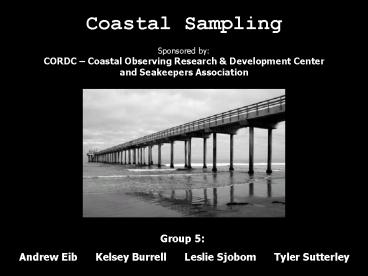Status - PowerPoint PPT Presentation
Title:
Status
Description:
Status – PowerPoint PPT presentation
Number of Views:40
Avg rating:3.0/5.0
Title: Status
1
Coastal Sampling Sponsored by CORDC Coastal
Observing Research Development Center and
Seakeepers Association
Group 5
Andrew Eib Kelsey Burrell Leslie Sjobom
Tyler Sutterley
2
The SeaKeepers Society
- The goal of the International SeaKeepers Society
is to protect the oceans by monitoring the
oceanographic changes - Long term goal is to construct an international
oceanographic observation network - Ocean Vessels
- Deep Sea Buoys
- Coastal Piers
International Network
Leslie
3
SK1000 Evaluation at CORDC
- Coastal Observing Research and Development Center
(CORDC) is evaluating the SeaKeeper 1000 system
for future pier deployments - Observation of biofouling and sedimentation
accumulation in system - Biofouling is the presence and accumulation of
biological organisms - Biofouling is an international problem resulting
in immeasurable financial losses - Biofouling causes deleterious effects on sensor
reading
Leslie
Existing Sensor Chamber
4
Existing System
Ocean-Monitoring Module SeaKeeper 1000TM
Sensor System
- Current Biofouling Prevention
- Use of Copper in Design
- Daily 5 Minute Localized Chlorine Generation
Method - Current Sedimentation Prevention
- Coarse Filtration at Input of Pump
- Small Settling Chamber
- System measurements
- 1 gpm flow speed
- 20 psi pressure
45 ft
Submersible Pump
15 ft
Ocean Floor
Leslie
5
Project Description
- Reduce Sedimentation w/in Sensor System
- Reduce Biofouling w/in Sensor System
- Reduce necessary system maintenance
- Maintain modular setup
SeaKeeper Module Sensor Biofouling
Leslie
6
Key Design DecisionsSedimentation
- Sedimentation Chamber
- Negative effects on real time
- measurements
- Severe mixing
- Filter
- Lack of centripetal action
- Mesh clogging
- Pressure purge control
- Hydrocyclone
VU Flow Filter
Kelsey
7
Hydrocyclone
- Centripetal forces
- Removes particulates
- of specific gravity gt 1
- Divided flow
- Clean overflow
- Sediment laden underflow
- (1/5 of input)
- Optimal range of specs
- More robust design
- No mesh
- No moving parts
Hydrocyclone
Kelsey
8
Hydrocyclone Testing
- Sediments pump in water reservoir
- Hose to maintain water level agitate
sediments - Hydrocyclone 20 ft above pump
Submerged Pump Testing
Sedimentation Agitation
Kelsey
9
Hydrocyclone Test Results
Underflow vs. Overflow Outputs
- 18 hour test
- No visible particle settling in overflow output
- 48 grams sediments in underflow output
Kelsey
10
Key Design DecisionsBiofouling
- Ozone
- Same treatment as chlorine
- Ultrasonic Transducer
- Power consumption
- UV
- Works well with chlorine
- Low power consumption
Ultrasonic Transducers
Andrew
11
UV Component
- Sterilight - Specs
- 19 Watt Power Consumption
- 40 mJ/cm² of UV
- NSF/EPA/US Public Health Standards
- UV penetrates an organisms cellular structure,
causing a molecular rearrangement of the DNA
structure, effectively eliminating bacteria,
mold, algae, fungi, and protozoa
Andrew
12
UV Test Procedure
- ATP testing of samples to determine the amount of
living material in each - Prior to UV
- After UV
Luminometer
Test Reagents
Andrew
13
UV Test Results
- Results
- Adenosine triphosphate
- 93 Reduction ATP
- ATP Life Biological growth
Andrew
14
Chlorinator Analysis
- Using MATLAB FloWorks
- Available head at pier
- Particle passing time from pump to pier
- Necessary run time determined
- 2 minutes 30 seconds
- Stall time dependent on chlorine concentration
Worst Case 1 minute and 41 seconds Average 1
minute and 14 seconds
Tyler
15
Sensor Configuration
- Series vs. parallel sensor connection
- Parallel (Existing)
- Smaller pressure losses
- No significant impact on thickness
- density of biofilm
- ReParallel 9000, ReSeries 9200
- Series
- No significant reduction in sedimentation
- Bore sensor chamber
- input/output
- Replace fittings
- Increase tube diameter
Parallel configuration
Series configuration
Tyler
16
FloWorks Analysis
- 5 Main Configurations
- Original Parallel
- New Parallel
- Series
- New Series
- New Series (Reverse)
Flow Velocity
Pressure Losses
Sedimentation Accumulation
Tyler
17
Final Design Solution
- Order of Components
- Hydrocyclone prior to UV to reduce
sedimentation - buildup in UV component
- Chlorinator prior to all to reduce biofouling
- w/in pump and hydrocyclone
Pump
Chlorinator
Hydrocyclone
Sensors
UV
Reduces Biofouling
Reduces Biofouling
Reduces Sedimentation
Tyler
18
Performance of Final Design
- Expected Results
- Hydrocyclone
- 99 Reduction of
- sedimentation
- Yearly maintenance
- UV Performance
- 93 Reduction in biofouling
- Complimentary to chlorine
- Yearly maintenance
Flow in
UV
Hydrocyclone
Flow out
Final housing of UV Hydrocyclone
Leslie
19
Future Recommendations
- Maintain existing chlorination system
- Yearly maintenance
- Replacement of UV bulb
- Clean out hydrocyclone
- Clean out UV chamber
- Monitor UV effects on optical
- measurements
- Close observation at regular
- intervals for 1st year
Preconditioning module integrated into final
system
Leslie
20
Acknowledgements
- Special Thanks to
- Eric Terrill Staff, CORDC
- Jerry Tustaniwskyj
- Michael Latz, SIO
- Geoff Morrison, SeaKeepers International
- Ken Duff, Scripps Machine Shop
- Marshalls Hardware
- Cheese Shop (best sandwiches ever)































